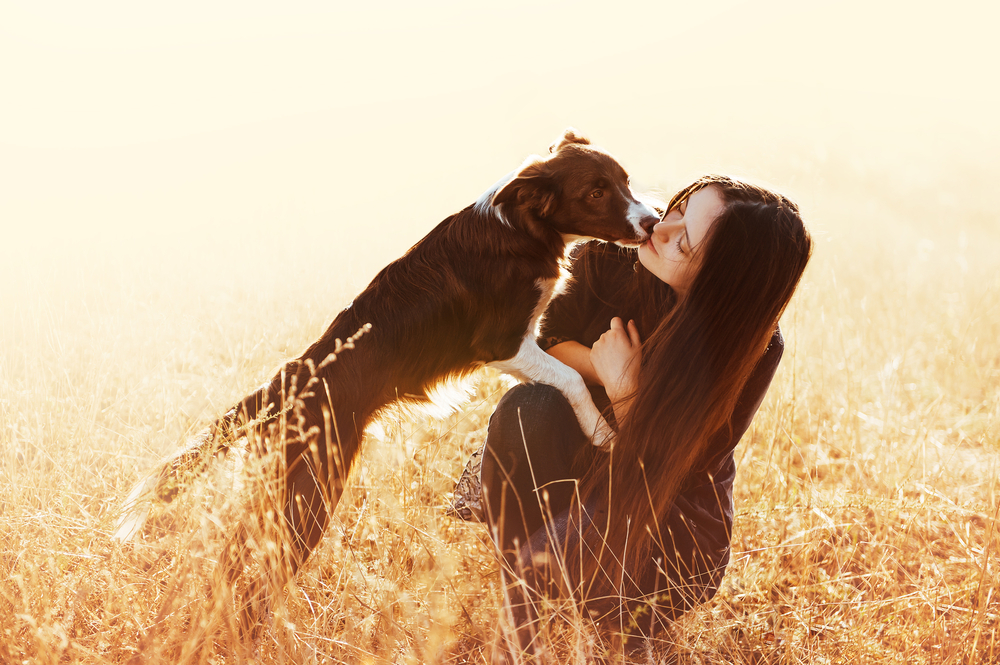Border Collies are one of the most popular breeds around. In fact, they are the 35th most popular according to the American Kennel Club. The Border Collie breed is perhaps the most famous of all the herding dogs. They are known for their high energy levels, intelligence, and sweet nature.
Border Collies are often seen in physical activities, including herding competitions, agility, frisbee competitions, dock diving, etc. The breed is extremely versatile, and catches onto new things quickly, making them perfect for almost any job, especially service work. Service dogs must be excited to work, smart, able to handle new experiences, and eager to please, all of which are traits of the Border Collie.
What are Service Dogs?

The definition of a service dog according to the U.S. Department of Justice as “dogs that are individually trained to do work or perform tasks for people with disabilities.” This is a very broad definition, and doesn’t quite clearly differentiate service animals from regular dog ownership.
Luckily, more legislation was provided on the definition of service dogs. The Americans with Disabilities Act (ADA) of 1990 gave a more specific definition for service dogs: “dogs that are individually trained to do work or perform tasks for people with disabilities. Examples of such work or tasks include guiding people who are blind, alerting people who are deaf, pulling a wheelchair, alerting and protecting a person who is having a seizure, alerting owners to a panic attack, reminding a person with mental illness to take prescribed medications, calming a person with Post Traumatic Stress Disorder (PTSD) during an anxiety attack, or performing other duties.”
Service dogs cover a wide range of tasks for each disability. Some common conditions that could benefit from a service dog include: anxiety attacks, paralysis, mental health problems, blindness, deafness, etc.
Types of Service Dogs
There are many different types of assistance dogs for different disabilities. Service dogs can help with nerve damage, paralysis, spinal cord injuries, blindness, and more. While some disorders are physical, some are mental, such as elopement disorder, autism, brain injury, autism, etc. Service dogs help their handlers with many tasks, but there are a few main types of service dogs we will discuss in this article.
Service dog: A service dog is the most common type and is the broadest category. A service animal can help with many things, but in this category, it is most often pups offering assistance with physical disabilities or impairments. They play a big part in their owners’ lives. Some common breeds of service dogs include the Golden Retriever, the Labrador Retriever, and the Collie.
- Guide dogs: These dogs are also known as seeing-eye-dogs and help people with vision loss navigate the world. A guide dog will help their handler avoid obstacles, open doors, maintain a steady pace, board public transport, etc. These are the oldest forms of service dogs, and date back to Pompeii, where illustrations show a blind man being led by a dog.
- Hearing dogs: These intelligent dogs assist their deaf handlers with sounds they cannot hear. They are trained to help their owners receive vital cues of sounds, including smoke or fire alarms, doorbells, door knocking, phones, alarm clocks, and even the person’s name.
- Medical alert dogs: These service dogs help owners suffering from seizures or epilepsy prepare for an upcoming seizure episode and keep them safe during it. Another type of service dog under this category is a diabetic assistance dog, who helps alert their owner when their blood sugar is low or can seek medical assistance if necessary. There are many other types of medical assistant dogs for dozens of diseases. Some dogs can now even sniff out
- Mobility assistance dogs: A mobility assistance dog is a type of service dog that helps humans with spinal injuries, leg injuries, or any injury that makes walking, standing or balancing difficult. These are typically larger breed dogs since they provide balance support for their handler. They help their human stay standing, open doors, walk, retrieve items, etc.
Psychiatric service dog: This special service dog assists people with mental disabilities or mood disorders. They have all the same rights as all the mentioned service dogs, but undergo specialized service dog task training to help their owners with mental or mood disorder needs. Some examples of this could be retrieving medication, providing comforting touches, finding a quiet place for their owner, making sure no one touches their owner, etc. These service dogs help with mental health issues rather than mobility issues.
Click the below video to learn more about psychiatric service dogs.
Therapy dog: A therapy dog is not a service dog, but instead a dog that provides emotional support and comfort to people in stressful situations. This is often a hospital or nursing home, but can also be schools, natural disaster sites, etc. They are not service animals as they don’t perform specific tasks for people with disabilities, but they do undergo specialized training, including passing an American Kennel Club Good Citizen test. Then, they visit anyone who could need comfort. They have a home and are a pet at the end of the day. Find out more about training your dog to become a therapy dog here. Therapy dogs provide important comfort to the patient, their family, and all around them. They have a very important job, but are not service animals.
Emotional support animal: An emotional support animal is a companion animal that provides emotional benefits to their owner. They do not undergo any special training, and are not a service animal. They do not provide assistance to any other people besides their owner, and mainly stay at home or can sometimes accompany their handler during travel. Any animal can become an emotional support animal with a doctor’s note, but they do not have the same rights as service dogs or assistance dogs. Newer laws have become more strict with emotional support animal’s ability to fly with their owners due to people pretending their emotional service animal is a service animal.
Emotional Support Dog vs. Psychiatric Service Dog: What’s the Difference?

While both emotional support dogs and psychiatric service dogs provide support to their owner, only a psychiatric service dog is a recognized service animal. These dogs undergo specialized task training and have federally protected rights, such as the right to accompany their owner anywhere, including businesses, schools, non-pet friendly housing, on airplanes, etc. They learn specific tasks to help their owner. Emotional support dogs and others do not go through task training, so they are just pets who provide comfort to their owner the way all pets do. To get a psychiatric service dog, you must be diagnosed with a disability and prescribed a service dog, who you will work with a trainer to train or train yourself, though we recommend working with a professional.
An emotional support dog only requires a letter of recommendation from a doctor. They are a pet who offers mental and emotional benefits to their owner, which can be very helpful, but they can’t accompany their owners in public places, nor do they have access on flights, in schools, etc. and have no federally protected rights. Dogs and cats are the most common types of ESAs, but any animal has the chance to become an ESA with a doctor’s note.
Emotional support animals are a hot topic due to their loose regulations and misuse. People commonly pretend their therapy dog or ESA is a service dog. They cite AKC papers or fake paperwork as proof of service dog status, which are just cons. They’ll bring their puppy or dog into stores with fake vests and cause disruptions and damage. Service dogs wear vests to set themselves apart, as they have a very important job and should be recognized as working dogs. Pretending a dog is a service dog is actually illegal in 20+ states and is very damaging to service dogs’ reputations. It makes life for people with disabilities much harder, and poses a challenge to service dog owners, making the conditions of service dogs worse.
Why Border Collies
Border Collies originated in Scotland and were bred to be herding dogs, which are instincts they still keep to this day. They are dogs who thrive when they have work and a job to do. They are known for their Border Collie stare, where they track what they’re herding and get in a low stance to watch carefully. They’ll let out a sharp bark to give a warning to move.
Border Collies are extremely intelligent and are commonly agreed to be the most intelligence dog breed. One Border Collie actually knew 1,000 nouns. This breed is notorious for their intelligence. They pick up well on hand gestures, body language, and learning new things very quickly. They are eager to please, which is a great trait for service dogs.
Border Collies do have a slight prey drive thanks to their herding dog nature, which is something to keep in mind. As herders, they are instinctually driven to chase prey and herd them, which can be trouble for small pets or small children. With proper training, this can be worked out though.
Border Collies are very high energy dogs. This breed is not a couch potato, after all, they belong to the herding dog group. Anyone who owns a Border Collie knows they are energetic dogs. They need plenty of exercise so they don’t become destructive when bored. They thrive on training and structure, especially if it’s a job to do. If they’re just a beloved family member, be sure to burn their energy off through physical activities such as long walks, runs, frisbee, etc. Any Border Collie could benefit from dock dive training or agility training, as it has many pros, including burning plenty of energy.
Border Collies stand around 19-22 inches tall and weigh around 30-55 pounds. They’re considered a medium-sized dog by most standards and have a life expectancy of around 13 years. They have a few different coat patterns, all of which are stunning enough to make anyone stop and stare. There are two types of coat, rough and smooth, both being coarse and a double coat.
They can be black with white markings, or they can be any bicolor, tricolor, merle, or solid color except white. This breed does require plenty of grooming, which is one of their very few cons.
Border Collies love people and pretty much all things, which is one of their best traits. They are eager to learn something new and participate in any and all activities. Their stature makes them a great size for being a service dog and their receptiveness to training is another great point about them. They’re perfect for any job, including service work, but shouldn’t be owned by just anyone. An owner must be committed to training. The last thing you want is a bored Border Collie giving you the classic breeds’ stare, with nothing to entertain them with.
This breed will answer to their owner with loyalty and devotion and follow them on most any journey. They are a very kind-hearted pup, love other dogs, and have too many positive traits to possibly count. Even when they’re not working, this dog is a loyal member of any family and will give themselves fully to those they love. They are perceptive of body language and moods, and love their people fully.
Border Collies as Service Dogs
Border Collies make an excellent choice as a service dog thanks to their size, intelligence, friendliness, and willingness to work. They will do a lot for their owners, and there is rarely something they won’t try to learn. A Border Collie service dog is guaranteed to be fearless, friendly, and loyal, all of which are ideal traits. This also makes them great therapy dogs, as they love to give and receive affection.
There are many pros to the Border Collie as a service dog. They are very intelligent, which is something vitally important for a service dog, as they must learn dozens of tasks to help their owner. They are very receptive to training, which is a great trait for a service dog, and they are a great stature and size for it. Their devotion to work is just one of their many great traits. Their famous stare is great to see during a training, because it means they are focused and alert.
Border Collies are not only one of the most intelligent breeds, but also one of the friendliest canines around. They are eager to befriend any member of the family, a puppy, other breeds, some farm animals, etc. They are extremely loyal to to their handler and their job.
There are a few cons with this breed as a service dog though. Due to their herding nature, they do have a prey drive for small animals or small children. They are also quite vocal dogs, and are not afraid to let out a bark unless trained not to. They must be kept busy, or they can become destructive, especially as a puppy. Their best traits can also be their worst. Since they are workaholics, they must be kept busy. You have to have an answer for their energy.
For someone with a physical disability, they have to be sure their dog is not a couch potato and is able to burn off the energy they need to stay fit and happy. The Border Collie does have some grooming needs as well, which should be noted as they require routine grooms. As long as you keep all of these things in mind, you and a Border Collie could greatly benefit from each other.
How to Get a Border Collie Service Dog

Are you interested in having a Border Collie as a service dog? Good news, the Border Collie is one of the more common service dog breeds, along with Golden Retrievers, Labrador Retrievers, and other Collies. They are intelligent enough to work with any disability, including PTSD, or to thrive as a therapy dog.
First, you’ll want to make sure you are able to receive a service dog. Service dogs are only given to people with disabilities that hinder their quality of life. For a psychiatric service dog, you must consult with a licensed mental health professional. This is the only legitimate way to acquire a service dog. For physical disabilities, you must consult with a doctor in your area. This is not a light decision to add a working dog as a member of your family.
If they recommend a service dog, the next step is finding a service dog for you. Look at rescues in your local area to see if they have any Border Collie or Border Collie mixes. Check out your local nonprofit organization rescues to see if you find any possible matches. If you adopt one or purchase one from a breeder, you will want to work with a service dog trainer or service dog program training to make sure your pooch becomes the best assistance dog possible. The Border Collie breed, and all canines, greatly benefit from training and some structure in their life. It takes a lot of time to train a service dog properly, so some patience is required.
If you go the route of a breeder, be sure to look for reputable breeders that stick to the breeds’ standards and treat their puppies and mothers ethically. This ensures you receive a healthy dog who will be the best assistant dog for you. Border Collies can be prone to certain illnesses, so it’s important to do some research to avoid this with a good breeder.
Conclusion
It’s obvious to see why Border Collies are such a beloved breed. The Border Collie has many loveable traits and their devotion to their job is outstanding. Whether they are a pet, therapy dog, or service animal, they change the lives of their owners and a service dog handler. This breed excels at many things. The Border Collie is a valid addition to any family, especially one with a disability or need for a work dog.
Are you looking for a psychiatric service dog?
Here at CertaPet, we can help. CertaPet is an online telehealth platform that improves access to mental health care in the U.S. with a focus on providing services to individuals who are seeking animal assisted interventions as part of their treatment plan.
We are currently coordinating with dog trainers who specialize in the service animal space and who will soon work in tandem with our network of licensed mental health professionals to make the process of getting and training a psychiatric service dog affordable, convenient, and hassle-free. We’ll have more information available soon about our Psychiatric Service Dog Training options. In the meantime, you can take our FREE pre-screening below to see if you qualify for a PSD!
FAQs
Why do Border Collies make good service dogs?
Border Collies are very friendly, extremely intelligent, love to work, and are extremely loyal. They are very popular service dogs and with good reason.
Can I handle a Border Collie?
Border Collies do require regular exercising and grooming, as well as mental stimulation. If you can handle that, a Border Collie can be a great pet or service animal for you.
Should I get a psychiatric service dog or emotional support animal?
Start by talking to a licensed mental health professional. Explain your symptoms and they can diagnose you with anxiety, PTSD, or any other ailment which may lead to a service dog. If you are not diagnosed with a disorder, you could still be prescribed an emotional support animal and benefit from that.
